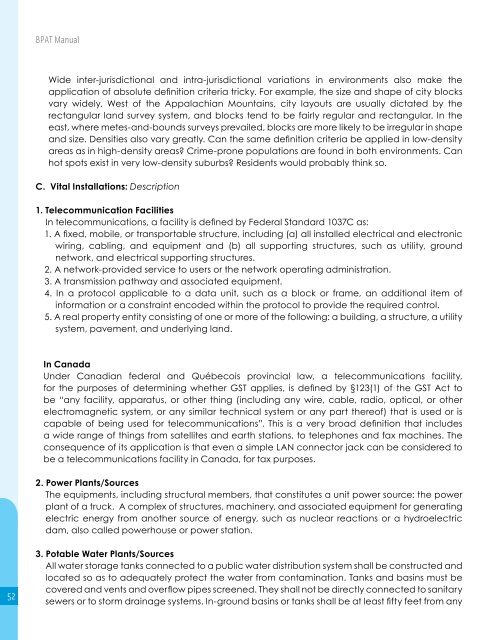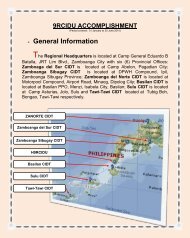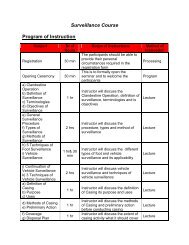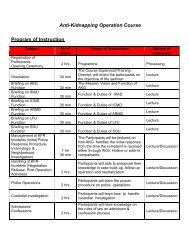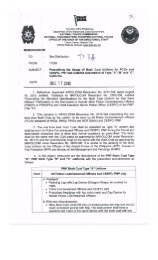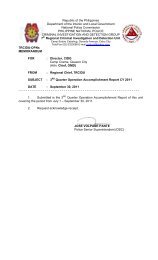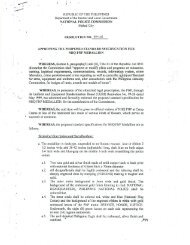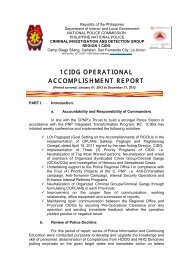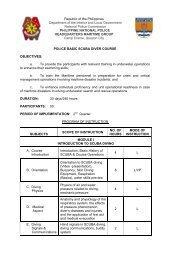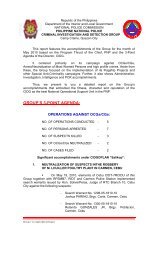Barangay Peacekeeping Operation - Philippine National Police
Barangay Peacekeeping Operation - Philippine National Police
Barangay Peacekeeping Operation - Philippine National Police
Create successful ePaper yourself
Turn your PDF publications into a flip-book with our unique Google optimized e-Paper software.
BPAT Manual<br />
Budget/Funding<br />
Wide inter-jurisdictional and intra-jurisdictional variations in environments also make the<br />
application of absolute definition criteria tricky. For example, the size and shape of city blocks<br />
vary widely. West of the Appalachian Mountains, city layouts are usually dictated by the<br />
rectangular land survey system, and blocks tend to be fairly regular and rectangular. In the<br />
east, where metes-and-bounds surveys prevailed, blocks are more likely to be irregular in shape<br />
and size. Densities also vary greatly. Can the same definition criteria be applied in low-density<br />
areas as in high-density areas? Crime-prone populations are found in both environments. Can<br />
hot spots exist in very low-density suburbs? Residents would probably think so.<br />
C. Vital Installations: Description<br />
part of the nearest subsurface sewage disposal system and twenty-five feet from any part of the<br />
nearest subsurface sewage disposal system and twenty-five feet from the nearest watercourse<br />
or storm drain. They shall be at least fifty feet from the nearest sanitary sewer unless the sewer<br />
is constructed of ductile or cast iron or pre-stressed concrete pressure pipe, steel cylinder type<br />
with a gasket joint, in which case it may be no closer than twenty-five feet. Exemptions may be<br />
sought for existing structures which do not conform to these requirements.<br />
4. Railways<br />
1. A railroad, especially one operated over a limited area: a commuter railway.<br />
2. A track providing a runway for wheeled equipment.<br />
1. Telecommunication Facilities<br />
In telecommunications, a facility is defined by Federal Standard 1037C as:<br />
1. A fixed, mobile, or transportable structure, including (a) all installed electrical and electronic<br />
wiring, cabling, and equipment and (b) all supporting structures, such as utility, ground<br />
network, and electrical supporting structures.<br />
2. A network-provided service to users or the network operating administration.<br />
3. A transmission pathway and associated equipment.<br />
4. In a protocol applicable to a data unit, such as a block or frame, an additional item of<br />
information or a constraint encoded within the protocol to provide the required control.<br />
5. A real property entity consisting of one or more of the following: a building, a structure, a utility<br />
system, pavement, and underlying land.<br />
In Canada<br />
Under Canadian federal and Québecois provincial law, a telecommunications facility,<br />
for the purposes of determining whether GST applies, is defined by §123(1) of the GST Act to<br />
be “any facility, apparatus, or other thing (including any wire, cable, radio, optical, or other<br />
electromagnetic system, or any similar technical system or any part thereof) that is used or is<br />
capable of being used for telecommunications”. This is a very broad definition that includes<br />
a wide range of things from satellites and earth stations, to telephones and fax machines. The<br />
consequence of its application is that even a simple LAN connector jack can be considered to<br />
be a telecommunications facility in Canada, for tax purposes.<br />
The use of public railways to deploy troops required special measures to run them and a special<br />
organization to deal with damage to track and rolling stock by the enemy and to inflict such<br />
damage upon them. The American civil war, fought over an area the size of Europe, could<br />
hardly have been fought without railways. Much of the land was not well-enough cultivated to<br />
enable armies to live off it and it was only by rail that the new vast armies could be supplied.<br />
5. Airports<br />
A place where aircraft can land and take off, usually equipped with hangars, facilities for<br />
refueling and repair, accommodations for passengers, etc.<br />
6. Seaports/Wharfs<br />
Seaport - a sheltered port where ships can take on or discharge cargo harbor, harbor, haven<br />
docking facility, dockage, dock - landing in a harbor next to a pier where ships are loaded and<br />
unloaded or repaired; may have gates to let water in or out; “the ship arrived at the dock more<br />
than a day late” landing place, landing - structure providing a place where boats can land<br />
people or goods<br />
Seafront - the waterfront of a seaside town<br />
Port - a place (seaport or airport) where people and merchandise can enter or leave a<br />
country<br />
Coaling station - a seaport where ships can take on supplies of coal<br />
2. Power Plants/Sources<br />
The equipments, including structural members, that constitutes a unit power source: the power<br />
Port of call - any port where a ship stops except its home port anchorage ground,<br />
plant of a truck. A complex of structures, machinery, and associated equipment for generating<br />
electric energy from another source of energy, such as nuclear reactions or a hydroelectric<br />
Anchorage - place for vessels to anchor<br />
dam, also called powerhouse or power station.<br />
7. Water Irrigations<br />
3. Potable Water Plants/Sources<br />
An establishment primarily engaged in operating water treatment plants and/or operating<br />
All water storage tanks connected to a public water distribution system shall be constructed and<br />
water supply systems. The water supply system may include pumping stations, aqueducts, and/<br />
located so as to adequately protect the water from contamination. Tanks and basins must be<br />
or distribution mains. The water may be used for drinking, irrigation, or other uses.<br />
52<br />
covered and vents and overflow pipes screened. They shall not be directly connected to sanitary<br />
sewers or to storm drainage systems. In-ground basins or tanks shall be at least fifty feet from any<br />
53


